Economics - Consumption Function | 12th Economics : Chapter 4 : Consumption and Investment Functions
Chapter: 12th Economics : Chapter 4 : Consumption and Investment Functions
Consumption Function
Consumption Function
1. Meaning of Consumption Function
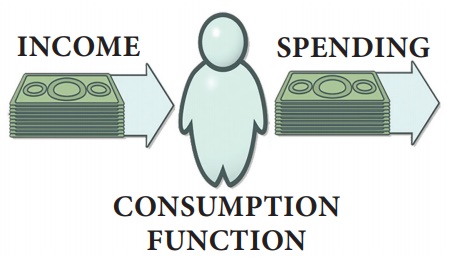
The consumption function or propensity to consume refers to income
consumption relationship. It is a “functional relationship between two
aggregates viz., total consumption and gross national income.”
Symbolically, the relationship is represented as
C= f (Y)
Where,
C = Consumption
Y = Income
f = Function
Thus the consumption function indicates a functional relationship
between C and Y, where С is the dependent variable and Y is the independent
variable, i.e., С is determined by Y. This relationship is based on the ceteris
paribus (other things being same) assumption, as only income consumption
relationship is considered and all possible influences on consumption are held
constant.
In fact, consumption function is a schedule of the various amounts of
consumption expenditure corresponding to different levels of income. A
hypothetical consumption schedule is given in Table 1.
Table : 1 Income - Consumption Schedule (₹Crores)
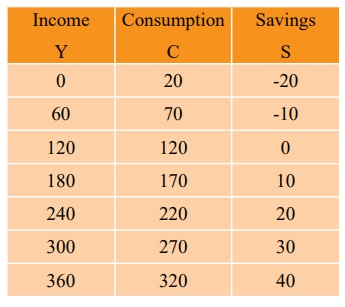
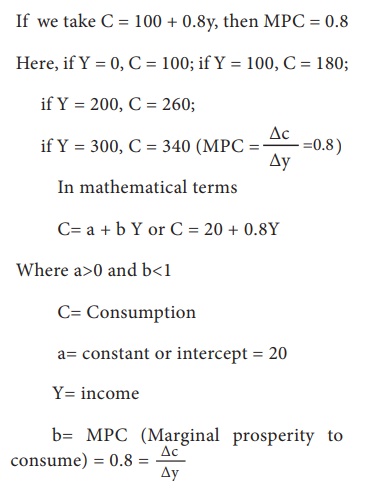
The above table shows that consumption is an increasing function
of income because consumption expenditure increases with increase in income.
Here it is shown that when income is zero, people spend out of their past
savings on consumption because they must eat in order to live (Autonomous
Consumption).
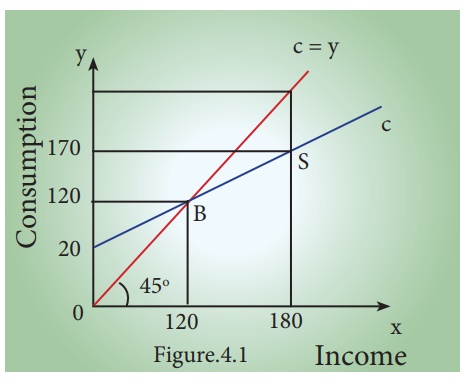
Here, when y = 120, C = 120 (Point B is the diagram)
When y = 180, C = 170, S = 10 (Point S is the diagram)
If Y increases to 360, C = 320, S = 40
In the diagram, income is measured horizontally and consumption is
measured vertically. In 45 line at all levels, income and consumption are
equal. It is a linear consumption function based on the assumption that
consumption changes by the same amount as does income.
Thus the consumption function measures not only the amount spent
on consumption but also the amount saved. This is because the propensity to
save is merely the propensity not to consume. The 45° line may therefore be
regarded as a zero-saving line, and the shape and position of the C curve
indicate the division of income between consumption and saving.
2. Technical Attributes of the Consumption Function
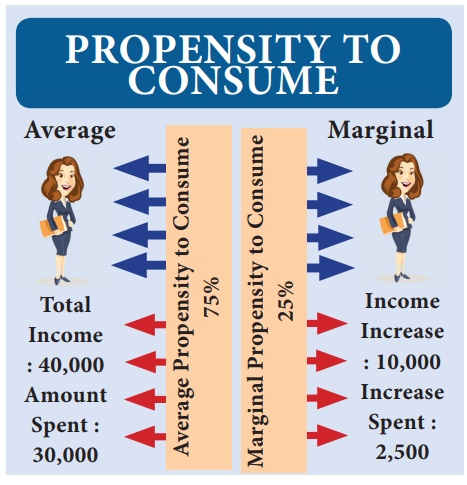
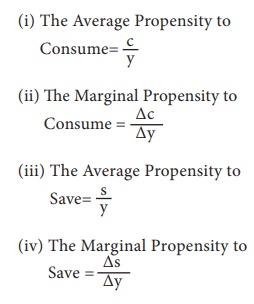
(1) The Average Propensity to Consume:
The average propensity to consume is the ratio of consumption
expenditure to any particular level of income.” Algebraically it may be
expressed as under:
APC = C/Y
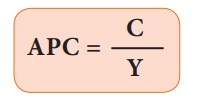
C= Consumption
Y = Income
(2) The Marginal Propensity to Consume:
The marginal propensity to consume may be defined as the ratio of
the change in the consumption to the change in income. Algebraically it may be
expressed as under:
MPC = ∆C/∆Y
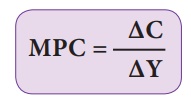
Where
ΔC= Change in Consumption
ΔY = Change in Income
MPC is positive but less than unity
0 < ∆C/∆Y < 1

(3) The Average Propensity to Save (APS) :
The average propensity to save is the ratio of saving to income.
APS is the quotient obtained by dividing the total saving by the
total income. In other words, it is the ratio of total savings to total income.
It can be expressed algebraically in the form of equation as under
APS = S/Y
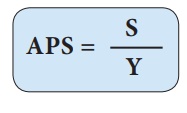
Where
S= Saving
Y=Income
(4) The Marginal Propensity to Save (MPS) :
Marginal Propensity to Save is the ratio of change in saving to a
change in income.
MPS is obtained by dividing change in savings by change in income.
It can be expressed algebraically as

MPS = ∆S/∆Y
ΔS = Change in Saving
ΔY= Change in Income
Since MPC+MPS=1
MPS=1-MPC and MPC = 1 - MPS
Generally the average ie APC is expressed in percentage and the
MPC in fraction.

3. Keynes’s Psychological Law of Consumption:
Keynes propounded the fundamental Psychological Law of Consumption
which forms the basis of the consumption function. He stated that “The
fundamental psychological law upon which we are entitled to depend with great
confidence both prior from our knowledge of human nature and from the detailed
facts of experience, is that men are disposed as a rule and on the average to
increase their consumption as their income increases but not by as much as the
increase in their income.” The law implies that there is a tendency on the part
of the people to spend on consumption less than the full increment of income.
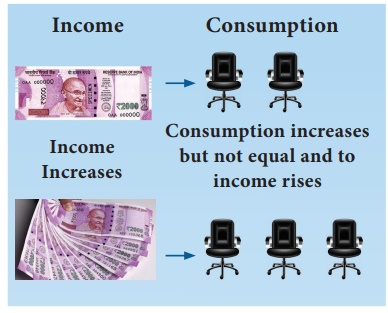
Assumptions:
Keynes’s Law is based on the following assumptions:
1. Ceteris paribus (constant extraneous variables):
The other variables such as income distribution, tastes, habits,
social customs, price movements, population growth, etc. do not change and
consumption depends on income alone.
2. Existence of Normal Conditions:
The law holds good under normal conditions. If, however, the
economy is faced with abnormal and extraordinary circumstances like war,
revolution or hyperinflation, the law will not operate. People may spend the
whole of increased income on consumption.
3. Existence of a Laissez-faire Capitalist Economy:
The law operates in a rich capitalist economy where there is no
government intervention. People should be free to spend increased income. In
the case of regulation of private enterprise and consumption expenditures by
the State, the law breaks down.
Propositions of the Law:
This law has three propositions:
(1) When income increases, consumption expenditure also increases
but by a smaller amount. The reason is that as income increases, our wants are
satisfied side by side, so that the need to spend more on consumer goods
diminishes. So, the consumption expenditure increases with increase in income
but less than proportionately.
(2) The increased income will be divided in some proportion
between consumption expenditure and saving. This follows from the first proposition
because when the whole of increased income is not spent on consumption, the
remaining is saved. In this way, consumption and saving move together.
(3) Increase in income always leads to an increase in both
consumption and saving. This means that increased income is unlikely to lead to fall in
either consumption or saving. Thus with increased income both consumption and
saving increase.
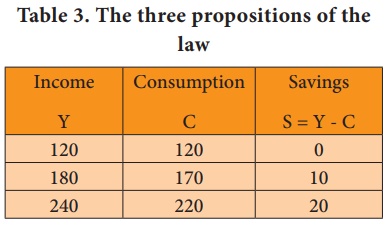
Proposition (1):
Income increases by ₹ 60 crores and the increase in consumption is
by ₹ 50 crores.
Proposition (2):
The increased income of ₹ 60 crores in each case is divided in
some proportion between consumption and saving respectively. (i.e., ₹ 50crores
and ₹ 10 crores).
Proposition (3):
As income increases consumption as well as saving increase.
Neither consumption nor saving has fallen.
Diagrammatically, the three propositions are explained in Figure
4.2. Here, income is measured horizontally and consumption and saving are
measured on the vertical axis. С is the consumption function curve and 45° line
represents income consumption equality.

Proposition (1):
When income increases from 120 to 180 consumption also increases
from 120 to 170 but the increase in consumption is less than the increase in
income, 10 is saved.
Proposition (2):
When income increases to 180 and 240, it is divided in some
proportion between consumption by 170 and 220 and saving by 10 and 20
respectively.
Proposition (3):
Increases in income to 180 and 240 lead to increased consumption
170 and 220 and increased saving 20 and 10 than before. It is clear from the
widening area below the С curve and the saving gap between 45° line and С
curve.
4. Determinants of Consumption function: Subjective and Objective Factors
J.M Keynes has divided factors influencing the consumption
function into two namely: Subjective factors and Objective factors
A) Subjective Factors
Subjective factors are the internal factors related to
psychological feelings. Major subjective factors influencing consumption
function are given below.
Keynes lists eight motives which lead individuals to
refrain from spending, they are:
1. The motive of precaution: To build up a reserve against unforeseen
contingencies. Eg. Accidents, sickness
2. The motive of foresight: The desire to provide for anticipated
future needs. Eg. Old age
3. The motive of calculation: The desire to enjoy interest and
appreciation.
4. The motive of improvement: The desire to enjoy for improving
standard of living.
5. The motive of financial independence.
6. The motive of enterprise (desire to do forward trading).
7. The motive of pride.(desire to bequeath a fortune)
8. The motive of avarice.(purely miserly instinct)
![]()
Keynes sums up the motives as Precaution, Foresight, Calculation,
Improvement, Independence, Enterprise, Pride and Avarice.
The Government, institutions and business corporations and
firms may also consume mainly because of the following four motives:
1. The motive of enterprise: The desire to obtain resources to carry
out further capital investment without incurring debt.
2. The motive of liquidity: The desire to secure liquid resources to
meet emergencies, and difficulties.
3. The motive of improvement: The desire to secure a rising income and
to demonstrate successful management.
4. The motive of
financial prudence:
The desire to ensure adequate financial provision against
depreciation and obsolescence and to discharge debt.
According to Keynes, the subjective factors do not change in the
short run and hence consumption function remains stable in the short period.
B) Objective Factors
Objective factors are the external factors which are real and
measurable. These factors can be easily changed in the long run. Major
objective factors influencing consumption function are:
1) Income Distribution
If there is large disparity between rich and poor, the consumption
is low because the rich people have low propensity to consume and high
propensity to save. The community with more equal distribution of income tends
to have high propensity to consume. This view has been corroborated by V.K.R.V.
Rao.
2) Price level
Price level plays an important role in determining the consumption
function. When the price falls, real income goes up; people will consume more
and propensity to save of the society increases.
3) Wage level
Wage level plays an important role in determining the consumption
function and there is positive relationship between wage and consumption.
Consumption expenditure increases with the rise in wages. Similar is the effect
with regard to windfall gains.
4) Interest rate
Rate of interest plays an important role in determining the
consumption function. Higher rate of interest will encourage people to save
more money and reduces consumption.
5) Fiscal Policy
When government reduces the tax the disposable income rises and
the propensity to consume of community increases. The progressive tax system
increases the propensity to consume of the people by altering the income
distribution in favour of poor.
6) Consumer credit
The availability of consumer credit at easy installments will
encourage households to buy consumer durables like automobiles, fridge,
computer. This pushes up consumption.
7) Demographic factors
Ceteris paribus, the larger the size of the family, the grater is
the consumption. Besides size of family, stage in family life cycle, place of
residence and occupation affect the consumption function. Families with
children of college education stage spend more than those of primary education
and urban families spend more than rural families.
8) Duesenberry hypothesis
Duesenberry has made two observations regarding the factors
affecting consumption.

a) The consumption expenditure depends not only on his current
income but also past income and standard ofliving.Astheindividuals are
accustomed to a particular standard of living, they continue to spend the same
amount on consumption even though the current income is reduced.
b) Consumption is influenced by demonstration effect. The
consumption standards of low income groups are influenced by the consumption
standards of high income groups. In other words, the poor people want to
imitate the consumption pattern of rich. This results in spending beyond their
income level.
9) Windfall Gains or losses
Unexpected changes in the stock market leading to gains or losses
tend to shift the consumption function upward or downward.
Related Topics